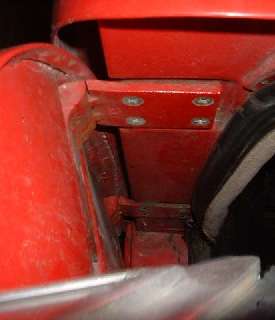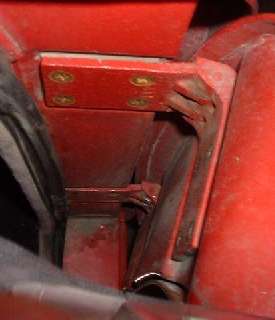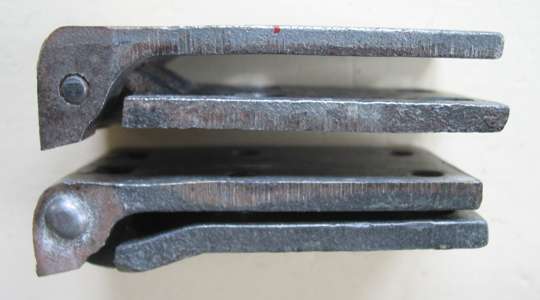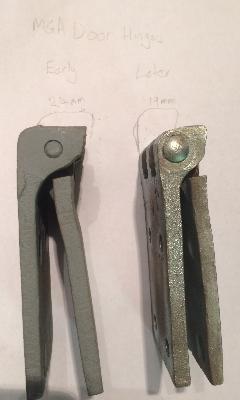The MGA With An Attitude
DOOR HINGE Variations -- BD-103B
At 01:11 PM 6/6/05 -0600, Will DeDalis wrote:
>"#10961/A stamped on hinge, I have four that came with the car in parts. All four have one leg that is offset with bend. I bought a door for parts, and it has hinges that do not have this offset. Which is which?"
I think the hinges are supposed to be flat on both sides. I have seen some with a bend, but I presume the bend was "installed" by some DPO having problems with alignment.
Hold the hinge so the wings are parallel. Measure the overall thickness across the mounting surfaces. If they are all the same overall thickness they should be interchangeable. If there is a slight bend on the front arm about at the door post corner, this may be accidental damage caused from forcibly opening the door too far, or it might be intentionally modified to allow opening farther. More bend might be accompanied by more shim at installation. Notice in picture below right there is a shim between hinge and body post for the top hinge.


There is one other difference to look for. I have two different types on my car. These are visibly different in the area of the small ears where the hinge pin passes through, and the arrangement of the stops. The one shown at left above will open to a greater angle than the one at right (about 85 degrees vs. 75 degrees) before hitting the stops. This is a factory change at Coupe 52916 in June 1958 and Roadster 56069 in September 1958, specifically to allow the doors to open farther for easier entry/exit. You need to use two the same on one door. If you use one of each, one will hit the stop first, and all of the door stop load will be taken on the one hinge, possibly breaking the hinge.
Addendum January 2010:
Here is a photo supplied by M.J. (Mike) Moore in Cheshire, UK, that has sparked some additional discussion. Notice the bend in the lower wing of the lower hinge in this picture.

 It is easy to tell from shape of the stop ears that the top one is the early design and bottom one is the later design that will open farther. Change point was at car no. 56069. The early hinges had RH and LH part numbers AFH1494 and .AFH2805 respectively, and no shim. Later hinges were AFH5832 same number both sides with the packing piece AFH5827 added at that production point. I usually say the quantity for packing pieces is "A/R" (as required) because later cars had them and earlier cars not, but any car could have a packing piece added or deleted as a field fix. Rumor is that the assembly workers were fond of bending hinges as a quick adjustment rather than swapping shims.
It is easy to tell from shape of the stop ears that the top one is the early design and bottom one is the later design that will open farther. Change point was at car no. 56069. The early hinges had RH and LH part numbers AFH1494 and .AFH2805 respectively, and no shim. Later hinges were AFH5832 same number both sides with the packing piece AFH5827 added at that production point. I usually say the quantity for packing pieces is "A/R" (as required) because later cars had them and earlier cars not, but any car could have a packing piece added or deleted as a field fix. Rumor is that the assembly workers were fond of bending hinges as a quick adjustment rather than swapping shims.
As far as I know (so far) all factory hinges were originally flat in standard design, but some may have been bent for assembly adjustment with no change of part number. I am not yet convinced that there was ever a third design. I have a pair of each type on my car, because I got some spares with replacement doors some years ago, and also replaced a broken hinge with a new aftermarket part more recently. All of my hinges are flat. I have one other report of such an offset hinge (4 on 1 car) about 5 years ago (10961/A stamped on the part), but I have always attributed this offset to either a body factory adjustment or a field fix along with body repairs. I have in fact adjusted a hinge in this manner myself using a torch and a vice.
Distance between A and B pillars on these cars varies considerably, far more than just the thickness of one or two shims. My car has pillar spacing 1/4-inch wider on one side than the other, and I've had it long enough (early enough) to know that it is in this form as original factory issue, not from a field fix. I have always suspected that the body factory assembly workers had a few different hinge shapes close at hand while assembling these things. Call them pre-bent hinges, thicker or thinner than standard size. Pillar spacing and door length final sizes may have been marked on the body parts before assembly, which would make it easy to select the right size hinges on first grab.
I also think the soft fiber packing pieces were intended to be originally used exactly 1 per hinge in all cars (once the packing pieces were introduced), seldom more or less, as they can be used to fine tune alignment rather than as compensation for larger parts variations. You can take advantage of the softness of these shims to affect fine tuning of the thickness (making them slightly wedge shape) while tightening the screws. I have a description of this process in article BD-103D. A few pennies per shim added to original materials cost can actually yield a substantial labor cost reduction in body assembly.
|